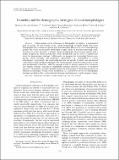Fecundity and the demographic strategies of coral morphologies
Abstract
Understanding species differences in demographic strategies is a fundamental goal of ecology. In scleractinian corals, colony morphology is tightly linked with many demographic traits, such as size-specific growth and morality. Here, we test how well morphology predicts the colony size-fecundity relationship in eight species of broadcast-spawning corals. Variation in colony fecundity is greater among morphologies than between species with a similar morphology, demonstrating that colony morphology can be used as a quantitative proxy for demographic strategies. Additionally, we examine the relationship between size-specific colony fecundity and mechanical vulnerability (i.e. vulnerability to colony dislodgment). Interestingly, the relationship between size-specific fecundity and mechanical vulnerability varied among morphologies. For tabular species, the most fecund colonies are the most mechanically vulnerable, while the opposite is true for massive species. For corymbose and digitate colonies, mechanical vulnerability remains relatively constant as fecundity increases. These results reveal strong differences in the demographic trade-offs among species of different morphologies. Using colony morphology as a quantitative proxy for demographic strategies can help predict coral community dynamics and responses to anthropogenic change.
Citation
Álvarez-Noriega , M , Baird , A H , Dornelas , M , Madin , J S , Cumbo , V R & Connolly , S R 2016 , ' Fecundity and the demographic strategies of coral morphologies ' , Ecology , vol. 97 , no. 12 , pp. 3485-3493 . https://doi.org/10.1002/ecy.1588
Publication
Ecology
Status
Peer reviewed
ISSN
1939-9170Type
Journal article
Description
JM, AB and SC were supported by fellowships from the Australian Research Council (FT110100609, FT0990652 and DP0880544 respectively). MD was supported by the ERC (BioTIME 250189) and the Scottish Funding Council (MASTS - HR09011).Collections
Items in the St Andrews Research Repository are protected by copyright, with all rights reserved, unless otherwise indicated.

